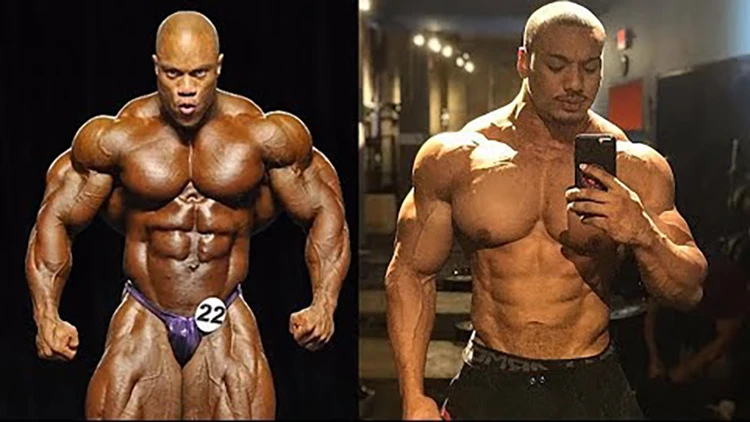
A powerlifter physique vs bodybuilder physique is pretty easy to spot with a trained eye because there’s clear differences in their muscular proportions and skeletal ratios, torso’s, fat storage and definition — just look at the image above of Phil Heath vs Larry Wheels.1
By comparing these key differences, you can decide which physique you’d like to go after and tell what other gym goers are training for too.
While both athletes can be found lifting in the gym, they way they train, their lifting goals and resulting appearances are vastly different so it’s important to consider which is preferred for any given athlete.
With this in mind, anyone can use the 5 key differences (with pics) below to distinguish if an athlete is a powerlifter or bodybuilder by looking at their physique alone—in addition to determining which physique and type of training you want to strive for.
Training for a Powerlifter Physique vs Bodybuilder Physique
Training for a powerlifter physique and bodybuilder physique has similarities but mainly differences because of the requirements of each class. Powerlifting is primarily a sport centered on strength; the goal is to maximize strength and is judged for performance in the three compound exercises—back squat and bench press.2
Bodybuilding, on the other hand, is about achieving a toned and symmetrical physique through strength training.3 A gymnast may have a toned body similar to bodybuilders but lack the varicose veins bodybuilding often causes. In the early stages of bodybuilding, individuals looking to gain muscle might participate in a beginner hypertrophy program to kickstart muscle growth (hypertrophy).
Training for a powerlifter physique focuses on achieving a 1RM (one rep max), with lifters typically practicing sumo deadlifts or the touch and go deadlift, using medium or wide grip bench presses, and opting for the low bar back squat. These choices will allow the lifter to maximize their lifts since the leverage is optimal and the largest muscles are employed, increasing raw strength.
Powerlifters will focus their training on low reps but with heavy weights, usually in the 1-5 rep range with a long rest period. They may also include training where reps are high to increase and maintain muscle but only for this purpose.
On the other hand, bodybuilders seek symmetry in their muscle groups and fat reduction. They will usually train in the higher rep ranges with anywhere between 8 and 15 reps with the goal of muscle development—rest periods are short—between 1 and 2 minutes.4 Due to the need for symmetrical growth, bodybuilders always include isolation exercises such as bicep curls along with compound movements.
Powerlifters concentrate on low repetitions with high heavy weight to allow them to reach high 1RPM, while bodybuilders tend to do high repetitions to induce muscle growth, translating into symmetry.
Both types of training do involve increasing muscle mass. As a result, both bodybuilders and powerlifters gain muscle and subsequently increase strength as the two are directly proportional. However, the manner in which the training is done results in different physiques.
Comparing Powerlifter Physiques vs Bodybuilder Physiques
Since the training methods differ, the physiques of both powerlifters and bodybuilders will vary. Both sets of athletes pay attention to their diets, but bodybuilders do so to ensure that they keep their gains, while powerlifters need calories to ensure that they continue to see growth and strength. There are 5 key differences with pics ranging from their torso appearances, muscle proportions, skeletal ratios, and fat storage to sheer muscle size that differentiate the two physiques.
Difference #1: Torso Appearance & Aesthetics
The torso appearances of bodybuilders and powerlifters (some considered strongmen) are noticeably different. Bodybuilders typically pay attention to their body fat percentages and, consequently, don’t have large guts. A larger gut is counterproductive to their goals or toned symmetrical physiques.
Some do, however, end up having thick six-packs due to ingesting human growth hormones (HGH) which assist the body speed up the repair of damaged muscles broken down after strength training.5 These could have the side effect of giving bodybuilders a thick six-pack.
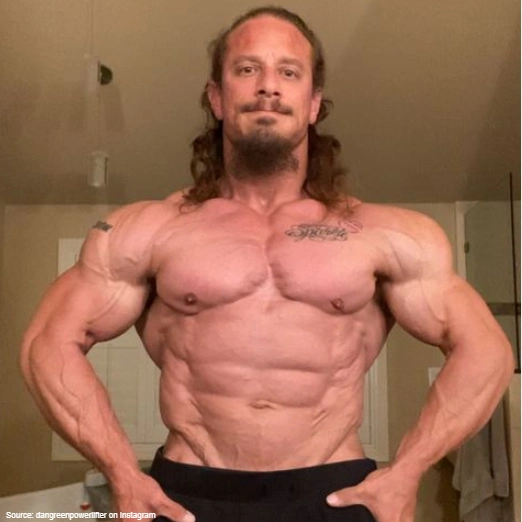
Note how Dan Green’s physique is very admirable, but overall his torso looks blocky from focusing on foundational lifts and he doesn’t have the classic v-taper that’s sought after in bodybuilding. Source: @dangreenpowerlifter on Instagram6
Powerlifters have no concern for their torso, whether large, small, or having them toned. They are not judged on appearance and ignore the aesthetics of their torso. It should be noted that the circumference of the torso is correlated with strength in the compound movements.7 Those with large torsos ends up performing better as powerlifters.
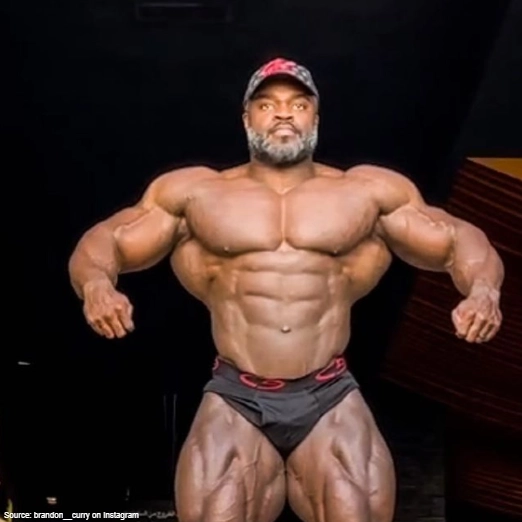
Now with Brandon Curry, the v-taper is quite noticeable since his lats and shoulders are so large, yet his abs and stomach are thin in comparison. Source: @brandon_curry on Instagram8
Difference #2: Muscle Proportions Between Powerlifter Physique & Bodybuilder Physique
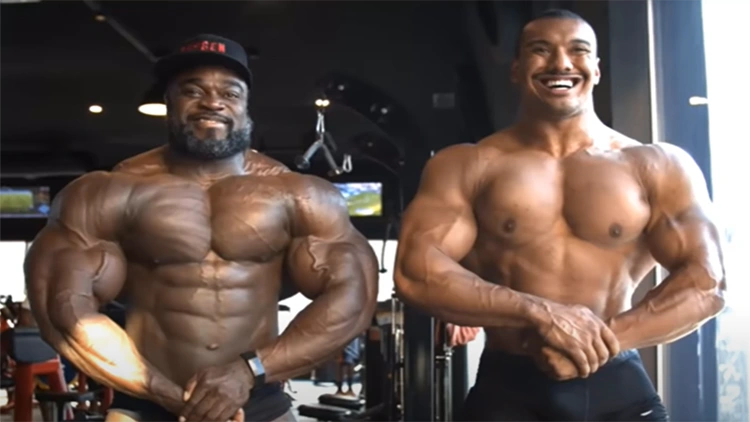
Brandon Curry, a professional bodybuilder is on the left, and Larry Wheels, a professional powerlifter is on the right. Clearly Brandon’s size and proportions are more aesthetic. Source: All About Olympia on Youtube1
Bodybuilder physiques are all about aesthetics and ensuring proportional symmetry in corresponding muscles. The ideal bodybuilder will have muscle proportions aligned with the Adonis Index formula. This formula describes males’ physiques as per Grecian ideals and has a ratio of 1:1618 for waist and shoulder size.9 In other words, bodybuilders strive to have shoulder size (clavicular length) 1.618 times the width of the waist. In addition to this, Greek alphas (the standard model for bodybuilders) would have:
- Calves flexed the same size as flexed biceps.
- The size of the flexed arm is 2.5 larger than the non-dominant waist
- The chest to be 6.5 times larger than the non-dominant wrist
- The upper leg should be 1.75 times larger than the knee
The bodybuilder would also have the tapered V shape due to the Adonis index—broad shoulders and narrow waist. With proper training, bodybuilders can often overcome bad shoulder, bad chest, and bad ab genetics to achieve significant growth.
Because powerlifters are judged on their performance on the 3 big lifts—deadlifts, back squats, and bench presses, their bodies will adapt to the stresses to handle this. This implies that the muscles that are recruited in these 3 will be developed and larger. The body will be conditioned to be a machine that handles these exercises efficiently.
There will be a lot of development on the glutes, quads, core, pecs, triceps, and traps. Muscles that are not involved will include the calves, biceps, and shoulders.
Difference #3: Skeletal Ratios & Fat Storage
Powerlifters and bodybuilders will have vast differences in terms of skeletal ratios and fat storage. Skeletal ratios refer to the differences between the proportions of the waist to shoulders. Some individuals will have hips and narrow shoulders (typical for females), and others will have narrow hips and broad shoulders, which is a typical appearance of the bodybuilder.
Bodybuilders would typically have tiny little waists, wide shoulders, and well-defined leg muscles, and are generally athletic. A lot of them also have chiseled abs, often overcoming bad ab genetics.
Powerlifters, on the other hand, have a blocky look to them and generally have large waists and fat on them—this is especially true for those in heavyweight classes. Those taking place in the lighter classes may be leaner similar to what a CrossFit physique would look like since the goal for both is gaining strength.
Powerlifters are not concerned with the amount of fat in their bodies; they tend to consume a lot of calories to ensure that their strength goals are met. Thirty percent of calories consumed by powerlifters should come from fat sources.10 These include grass-fed beef, whole eggs, and dairy products—powerlifters usually have 10-15 % body weight fat.
Both bodybuilders and powerlifters initially increase their calorie intake to build muscle during the off-season, known as peaking.11 The extra intake will allow for optimal recovery due to the damage caused to the muscles during strength training.
Before a competition, however, bodybuilders prepare by reducing their calorie intake, sometimes creating a 1000 calorie deficit to minimize body fat. They may achieve this by using peptides for weight loss and muscle gain.
Male bodybuilders usually maintain a 3-8% body fat percentage, while that of females should be around 10%. Bodybuilders may also reduce training volume, especially during the off-season. This raises the issue of the amount of muscle you lose on a cut. They do so efficiently by using the downtime as a springboard to hit the weights aggressively with minimal muscle loss.
There are three body types—ectomorph, endomorph, and mesomorph. The adage is that:
- Endomorphs carry fat with the potential to gain muscle
- Ectomorphs are lean and struggle to gain muscle and
- Mesomorphs are lean and muscular naturally, with the potential to pack on muscle
Other individuals will fall outside these body types—they are those who quickly put on body fat but not muscle or individuals who can quickly gain muscle, are lean but don’t just have the upper body that is typical of a mesomorph, etc. Considering this, body type will not matter; the difference in technique and diet between powerlifters and bodybuilders will ultimately determine how their physiques will appear.
Difference #4: Muscle Size
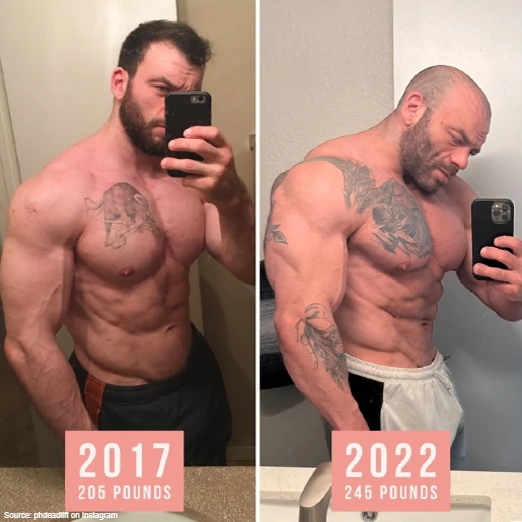
On the left is Ben Pollack in 2017 when he focused on powerlifting. He’s pretty big but…. On the right, Ben is 40 pounds heavier and has much, much larger muscles from focusing on bodybuilding and changes in his regimen. Source: @phdeadlift on Instagram12
Muscle size is a subtle difference that distinguishes between a powerlifter physique vs bodybuilder physique. The bodybuilder’s objective is to build as much lean muscle as possible while maintaining excellent proportionality. Bodybuilders will not only engage the “3 big lifts” but will also go out of their way to include isolation exercises to ensure individual muscle groups adequately receive stimulation.
As mentioned, this is evidenced by the higher number of reps that these individuals perform to meet their training goals which are 6-12 reps. They also increase the muscle’s time under tension, even at the expense of a reduced range of motion. Bodybuilders will also use machines to isolate the muscles and ensure the most amount of stress to increase muscle size and achieve hypertrophy (growth in muscle size).13
Bodybuilders often use techniques like daily undulating periodization to build muscle, involving workouts with varying intensity and volume.
Powerlifters do not care about muscle size. It is all about strength to achieve the 1RM in the three lifts. With that being said, it does not mean that their muscles will not increase in size; muscles will need to get bigger to get stronger. This class will dedicate their workouts to lower reps but using heavy weights to achieve raw strength—the muscle’s ability to apply force against resistance.
As a result, powerlifters, while being massive themselves, will not have quite the same size of muscle as bodybuilders who target all the muscles in the body for mass and symmetry. Powerlifters’ physiques will develop muscles to deal with the 3 big lifts.
Difference #5: Definition
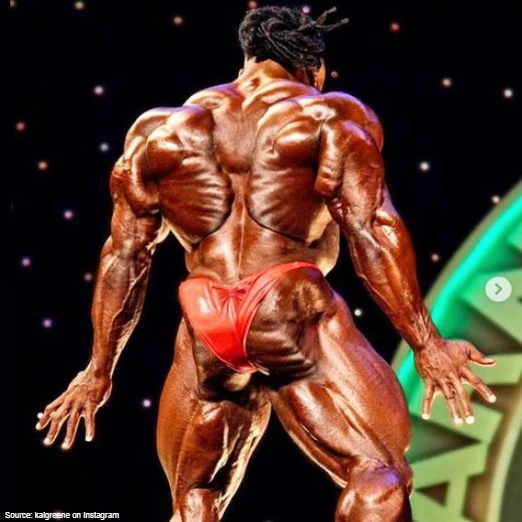
Kai Greene showing insane muscular definition and striations where you can see every muscles insertion point. Source: @kalgreene on Instagram14
Bodybuilders are all about definition, which translates to better aesthetics and contributes to better stage appearance, which is judged in a competition. As they tend to have very low body fat percentages, their muscles which are already larger than powerlifters will be very well defined to allow them to have complete symmetry.
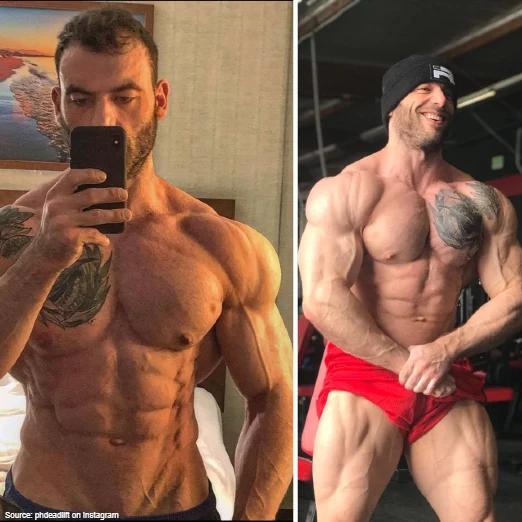
On the left is Ben Pollack before a powerlifting meet and he’s very, very lean but on the right is Ben within a week of the same powerlifting meet showing that definition isn’t sought after in powerlifting, although it can be a byproduct of cutting weight for a meet. Source: @phdeadlift on Instagram12
Many powerlifters are considered obese due to their body fat percentages. This high-fat content will lead to an apparent loss of definition since for muscles to appear sculpted; there has to be a low amount of fat in the body. The powerlifter’s goal is to haul as much weight as possible regardless of any other variables and, as a result, does not have symmetrical and defined physiques.
They also don’t typically isolate their compound movements; they may do so on occasion to continue the strengthening regimen, but it is not the main focus of their training. They aim to include as many muscle groups as possible to lift the weight and not isolate and activate a muscle. Powerlifters do not typically lean down for competition since this isn’t a requirement as being lean is not a big deal in some weight classes.
The two images below show Ben Pollack when he was a powerlifter, and the second image is when he subsequently transitioned into bodybuilding—there is much more definition in his body in the second image.
Which Is Best for You: A Bodybuilder Physique or Powerlifting Physique?
At the end of the day, the type of physique—be it bodybuilding or powerlifting—will be determined by what the lifter going to the gym is trying to accomplish. They might aim to build muscle, shed fat, or simply maintain a healthy lifestyle and stay fit.
If the goal is to develop muscle, have an aesthetic appeal, and reduce the amount of body fat, then a bodybuilder physique is ideal. Typically, this routine would incorporate aerobic activity and a focus on maintaining a proper diet to attain a physique similar to the top 10 bodybuilders of all time.
However, too much focus on developing muscles could lead to detrimental behavior (muscle dysmorphia), leading to reckless behavior such as consumption of anabolic steroids, which may have dangerous side effects.15
Some individuals may look to get strong and don’t care much about building symmetrical or proportionate muscle. They are looking for the functional aspect of weightlifting, which is simply getting stronger—a powerlifting physique would suit these individuals. Powerlifters often forego activities such as cardio or do not pay too much attention to body fat percentages and the diet that goes along with that.
Individuals aiming to enhance their fitness can opt to blend the two training styles known as power building, gaining the benefits of both methods while mitigating their drawbacks. This approach integrates cardio into the training regimen and emphasizes the importance of sufficient sleep—concerning whether 7 hours of sleep is enough for muscle building. All variables must be considered while working towards the desired physique.
When choosing between a powerlifter physique vs bodybuilder physique, lifters should consider what is best for them and their ultimate fitness goals; these 5 key differences with pics should give an idea to make an informed decision.
References
1BODYBUILDER VS POWERLIFTER | THE DIFFERENCE.” YouTube, 11 November 2019. Accessed 30 March 2023. <https://www.youtube.com/watch?v=rDejw8aPXUE>
2Medicine, N. L. (2019, July). Classic Powerlifting Performance: A Systematic Review. Retrieved 2022, from <https://journals.lww.com/nsca-jscr/Fulltext/2019/07001/Classic_Powerlifting_Performance__A_Systematic.21.aspx>
3Wikipedia. (2022, September 4). Bodybuilding. Retrieved 2022, from <https://en.wikipedia.org/wiki/Bodybuilding>
4Medicine, N. L. (2016, April 1). Increasing Lean Mass and Strength: A Comparison of High Frequency Strength Training to Lower Frequency Strength Training. Retrieved 2022, from <https://www.ncbi.nlm.nih.gov/pmc/articles/PMC4836564/>
5School, H. H. (2021, August 13). Growth hormone, athletic performance, and aging. Retrieved 2022, from <https://www.health.harvard.edu/diseases-and-conditions/growth-hormone-athletic-performance-and-aging>
6BOSS DAN GREEN (@dangreenpowerlifter) • Instagram photos and videos.” Instagram. Accessed 30 March 2023. <https://www.instagram.com/dangreenpowerlifter/>
7Medicine, N. L. (2020, December 1). Relationships Between Anthropometry and Maximal Strength in Male Classic Powerlifters. Retrieved 2022, from <https://pubmed.ncbi.nlm.nih.gov/33414873/>
8Brandon Curry (@brandon__curry) • Instagram photos and videos.” Instagram. Accessed 30 March 2023. <https://www.instagram.com/brandon__curry/>
9Risley, K. (2021, November 17). Adonis Index: Definition + How to Calculate It (2022). Lift Vault. Retrieved September 26, 2022, from <https://liftvault.com/resources/adonis-index/>
10Nutrition, J. o. (2010). Macronutrient intake in Collegiate powerlifters participating in off-season training. Retrieved 2022, from <https://jissn.biomedcentral.com/articles/10.1186/1550-2783-7-S1-P8>
11Henderson, Z. J. (2016, March). PEAKING AND TAPERING IN ENDURANCE ATHLETES: A REVIEW . Retrieved 2022, from <https://www.researchgate.net/publication/304675571_Peaking_and_Tapering_in_Endurance_Athletes_A_Review>
12IFBB Pro Dr. Ben Pollack (@phdeadlift) • Instagram photos and videos.” Instagram. Accessed 30 March 2023. <https://www.instagram.com/phdeadlift/>
13Schoenfeld, B. J. (2010, October). The Mechanisms of Muscle Hypertrophy and Their Application to Resistance Training. Retrieved 2022, from <https://journals.lww.com/nsca-jscr/Fulltext/2010/10000/The_Mechanisms_of_Muscle_Hypertrophy_and_Their.40.aspx>
14Kai Greene (@kaigreene) • Instagram photos and videos.” Instagram. Accessed 30 March 2023. <https://www.instagram.com/kaigreene/>
15Medicine, N. L. (2018, June 11). Muscle Dysmorphia and its Associated Psychological Features in Three Groups of Recreational Athletes. Retrieved 2022, from <https://www.ncbi.nlm.nih.gov/pmc/articles/PMC5995876/>